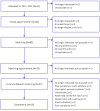The effectiveness of an additive informal social network intervention for forensic psychiatric outpatients: results of a randomized controlled trial
- PMID: 37293397
- PMCID: PMC10244564
- DOI: 10.3389/fpsyt.2023.1129492
The effectiveness of an additive informal social network intervention for forensic psychiatric outpatients: results of a randomized controlled trial
Abstract
Objectives: A supportive social network is associated with better mental health and wellbeing, and less criminal behavior. Therefore, this study examined the effectiveness of an additive informal social network intervention to treatment as usual (TAU) among forensic psychiatric outpatients.
Materials and methods: An randomized controlled trial (RCT) was conducted in forensic psychiatric care, allocating eligible outpatients (N = 102) to TAU with an additive informal social network intervention or TAU alone. Participants receiving the additive intervention were matched to a trained community volunteer over 12 months. TAU consisted of forensic care (e.g., cognitive behavioral therapy and/or forensic flexible assertive community treatment). Follow-up assessments were conducted at 3, 6, 9, 12, and 18 months after baseline. The primary outcome was the between-group effect on mental wellbeing at 12 months. Between-group effects on secondary outcomes (e.g., general psychiatric functioning, hospitalization, criminal behavior) were explored.
Results: Intention-to-treat analyses showed non-significant between-group effects on mental wellbeing on average over time and at 12 months. However, significant between-group effects were found on hospitalization duration and criminal behavior. Specifically, TAU participants were hospitalized 2.1 times more days within 12 months and 4.1 more days within 18 months than participants in the additive intervention. Furthermore, TAU participants reported 2.9 times more criminal behaviors on average over time. There were no significant effects on other outcomes. Exploratory analyses revealed that sex, comorbidity, and substance use disorders moderated effects.
Conclusion: This is the first RCT examining the effectiveness of an additive informal social network intervention in forensic psychiatric outpatients. Although no improvements were found on mental wellbeing, the additive intervention was effective in reducing hospitalization and criminal behavior. The findings suggest that forensic outpatient treatment can be optimized by collaborating with informal care initiatives aimed at improving social networks within the community. Future research is warranted to determine which specific patients might benefit from the intervention and if effects can be improved by extending the intervention duration and enhancing patient compliance.Clinical Trial Registration: [https://trialsearch.who.int/Trial2.aspx?TrialID=NTR7163], identifier [NTR7163].
Keywords: criminal recidivism; forensic psychiatry; informal social network intervention; mental wellbeing; psychiatric functioning; randomized controlled trial; social support; volunteer mentoring and befriending.
Copyright © 2023 Swinkels, van der Pol, Twisk, ter Harmsel, Dekker and Popma.
Conflict of interest statement
The authors declare that the research was conducted in the absence of any commercial or financial relationships that could be construed as a potential conflict of interest.
Figures


Similar articles
-
Patients' and volunteer coaches' experiences with an informal social network intervention in forensic psychiatric care: a qualitative analysis.BMC Psychiatry. 2023 Apr 26;23(1):290. doi: 10.1186/s12888-023-04594-2. BMC Psychiatry. 2023. PMID: 37101177 Free PMC article.
-
Improving mental wellbeing of forensic psychiatric outpatients through the addition of an informal social network intervention to treatment as usual: a randomized controlled trial.BMC Psychiatry. 2020 Aug 25;20(1):418. doi: 10.1186/s12888-020-02819-2. BMC Psychiatry. 2020. PMID: 32842971 Free PMC article. Clinical Trial.
-
Systematic reviews of the effectiveness of day care for people with severe mental disorders: (1) acute day hospital versus admission; (2) vocational rehabilitation; (3) day hospital versus outpatient care.Health Technol Assess. 2001;5(21):1-75. doi: 10.3310/hta5210. Health Technol Assess. 2001. PMID: 11532238 Review.
-
Psychological interventions for antisocial personality disorder.Cochrane Database Syst Rev. 2020 Sep 3;9(9):CD007668. doi: 10.1002/14651858.CD007668.pub3. Cochrane Database Syst Rev. 2020. PMID: 32880104 Free PMC article.
-
Moderated Online Social Therapy for Carers of Early Psychosis Clients in Real-World Settings: Cluster Randomized Controlled Trial.JMIR Ment Health. 2023 Sep 6;10:e47722. doi: 10.2196/47722. JMIR Ment Health. 2023. PMID: 37672335 Free PMC article.
Cited by
-
Targeted interventions to improve the social and economic circumstances of people with mental ill-health from marginalised communities: a systematic review.Psychol Med. 2025 Jul 28;55:e217. doi: 10.1017/S0033291725101128. Psychol Med. 2025. PMID: 40717551 Free PMC article.
-
Patients' and volunteer coaches' experiences with an informal social network intervention in forensic psychiatric care: a qualitative analysis.BMC Psychiatry. 2023 Apr 26;23(1):290. doi: 10.1186/s12888-023-04594-2. BMC Psychiatry. 2023. PMID: 37101177 Free PMC article.
References
-
- ter Haar-Pomp L, Spreen M, Volker B, Bogaerts S. The impact of forced forensic psychiatric confinement on composition and structure in the personal networks of personality-disordered forensic psychiatric patients. J Forens Psychiatry Psychol. (2019) 30:53–75. doi: 10.1080/14789949.2018.1467947 - DOI
-
- Ward T, Brown M. The good lives model and conceptual issues in offender rehabilitation. Psychol Crime Law. (2004) 10:243–57. doi: 10.1080/10683160410001662744 - DOI
-
- Barnao M, Ward T, Robertson P. The good lives model: a new paradigm for forensic mental health. Psychiatr Psychol Law. (2016) 23:288–301. doi: 10.1080/13218719.2015.1054923 - DOI
LinkOut - more resources
Full Text Sources

